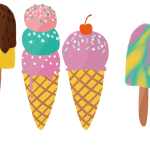Sugar Addiction, Sweet Tooth: Are They Different? by Joan Kent, PhD
Recently, a friend with a self-proclaimed sweet tooth asked me if it was the same as sugar addiction. The question brought out the geek in me, so I explored the difference. There is one.
Why We Like Sweet
Humans are hardwired to like sweet. In fact, a fetus will increase its swallowing of amniotic fluid if the fluid is artificially sweetened.
One author attributed our liking for sweet tastes to evolution. Millions of years ago we figured out that many plants that seem edible contain substances that can poison us. Because that didn’t happen with sweet foods, they became “safe.”
Brain chemicals have a lot to do with liking sweet. Endorphins (beta-endorphin), dopamine, and serotonin are natural feel-goods that make us enjoy and want the sugary foods that trigger them.
So we like sweet stuff.
Some of us have a particular fondness for sweet foods – a sweet tooth – and may eat more of those foods than would be considered average, or healthful. People with a sweet tooth may show a preference for sweet foods when faced with a choice and may even crave sugars at times.
I suspect neurochemical and/or hormonal reasons are behind those preferences, but let’s just say for now that some people like sugar more than average.
Other people – and I was one of them – go beyond liking sweet foods into having a compulsion to eat them. This may be a sign of an addiction to sugar.
Sugar Addiction Details
Addiction criteria apply well to sugar addiction. Let’s look at the section on Substance Abuse Disorder from the Diagnostic and Statistical Manual of Mental Disorders, Fifth Edition (DSM-5).
DSM-5 criteria for addiction are clustered in four groups but are essentially the same as DSM-IV criteria. I’ve listed the criteria below without the clusters. Examples given are just a few of many possible ones.
The severity of the disorder depends on the number of criteria present: 2 or 3 indicate mild, 4 or 5 indicate moderate, and 6 or more indicate severe substance abuse disorder. Some criteria may seem to apply only to illegal drugs, such as spending a great deal of time obtaining them. Sugar, in contrast, is available everywhere, in unlimited quantities and relatively inexpensively, but stay with me on this.
DSM-5 Criteria for Substance Abuse Disorder
- Taking more of the substance, or for a longer period, than intended
Lack of control over what or how much one is eating characterizes binge-eating disorder. Chocoholics describe an inability to resist, moderate, or stop eating chocolate. Clients keep eating cake, one slice after another, despite planning to stop after one piece.
- Unsuccessful efforts to stop or limit use
Dieting and weight cycling are found in binge eating and other eating disorders. Secret-eater chocoholics try unsuccessfully to reduce intake of chocolate, then relapse and overeat it.
- A great deal of time spent obtaining, using, or recovering from use
Eighty percent of chocoholics state that chocolate interferes with their lives in some way. Purging behaviors might take increasing time. Excessive exercise, one example, could interfere with important activities or occur despite injury.
- Craving the substance
Craving (an intense desire for a substance) is a common response to withdrawal or abstinence. Cravings are stronger after high levels of intake but can occur in other conditions. Cravings identify the substance that will relieve them: what you crave will take away the craving. (That’s a poor way to deal with cravings, but that’s separate topic!)
- Failure to fulfill major obligations due to use
- Continued use despite social problems caused or exacerbated by use
- Giving up or reducing important activities because of substance use
Points 5-7 could show up as eating alone due to embarrassment over the eating; refusing to wear bright colors, form-fitting outfits, or swimsuits; refusing to attend social events, eat in public, be nude in front of others, make love with the lights on, look in the mirror, go to a gym with mirrors, or even go to a gym at all.
- Recurrent use in hazardous situations
A client almost caused a car accident because she ran into a store to buy candy and “couldn’t get the chocolate into my mouth fast enough.” Hypoglycemia can cause other hazards.
- Continued use despite physical or psychological problems that are caused or exacerbated by substance use
Physical problems may include obesity, diabetes, hypertension, cardiovascular disease, and other conditions. Chocoholics eat chocolate despite migraines or feeling sick.
- Tolerance to the substance (needing more to get the same effect)
Tolerance is reduced effectiveness of an addictive substance, so a larger dose is needed to obtain the same effect. Tolerance occurs with sweet substances. Both sugar and artificial sweeteners can change endorphin (beta-endorphin) function through up- or down-regulation.
Serotonin is a brain chemical that alleviates pain, and tolerance can occur to its effects. Serotonin production is higher when insulin release is higher, so eating more sugar yields more serotonin, and may be a response to tolerance.
- Withdrawal symptoms when not using or when using less
Withdrawal is a set of symptoms that addictive substances produce when chronic use stops or drops. It includes physical symptoms or negative moods as specific brain chemicals decrease.
Eating more sugar or a sugary food (like fruit) will relieve withdrawal.
Positive reinforcers establish addiction by causing pleasure. Negative reinforcers alleviate the pain or distress caused by the addiction. If sugar takes away the discomfort of withdrawal, the sugar is a negative reinforcer, even if it started as a positive reinforcer.
Most addictions end up being about negative reinforcement to stop withdrawal. The negative reinforcer can be either sugar itself or a substitute, but if it stops withdrawal symptoms, it has addictive potential. I’m thinking fruit, agave syrup, coconut sugar, various sweeteners.
One withdrawal symptom is craving – an intense urge or desire for a substance. Cravings are highest when withdrawal is most severe. The greater the intake, the greater the withdrawal and craving.
Among women, chocolate is the most craved food. Chocolate contains stimulants and mood elevators, including caffeine, theobromine (like caffeine), tyramine, and phenylethylamine (the being-in-love chemical).
Yet when chocolate isn’t available, participants choose sweet substitutes, rather than stimulants like caffeine.
To that guy who loves to tell me that drug info doesn’t apply to food: Sugar isn’t food; it’s a drug.
Some journal articles, often by a particular group of researchers, “prove” sugar does nothing bad. In some cases, the sugar industry paid for the research. Enough said.
If you’d like help with sugar, why not visit LastResortNutrition.com and grab your free Sugar-Quitting Consult? Discover how easy it can be to take charge of sugar and change your life!
Brought to you by Dr. Joan Kent, best-selling author of Stronger Than Sugar.



